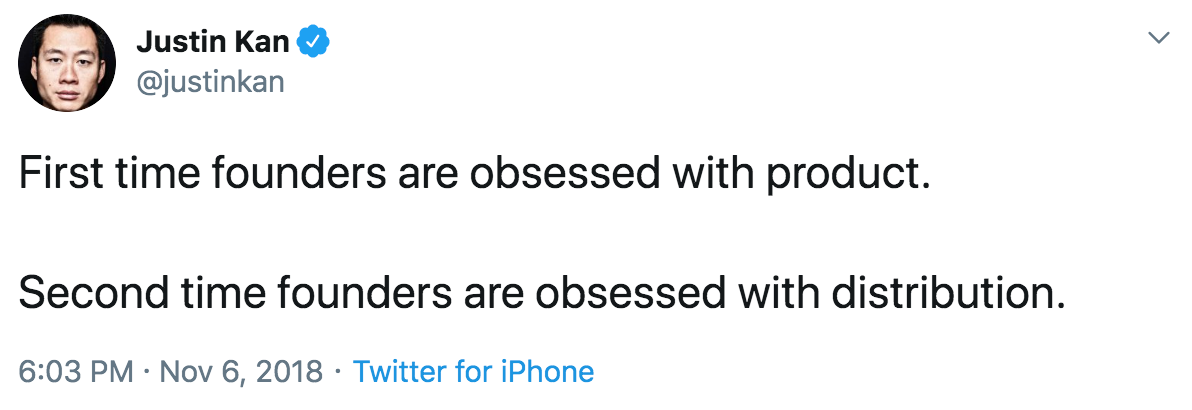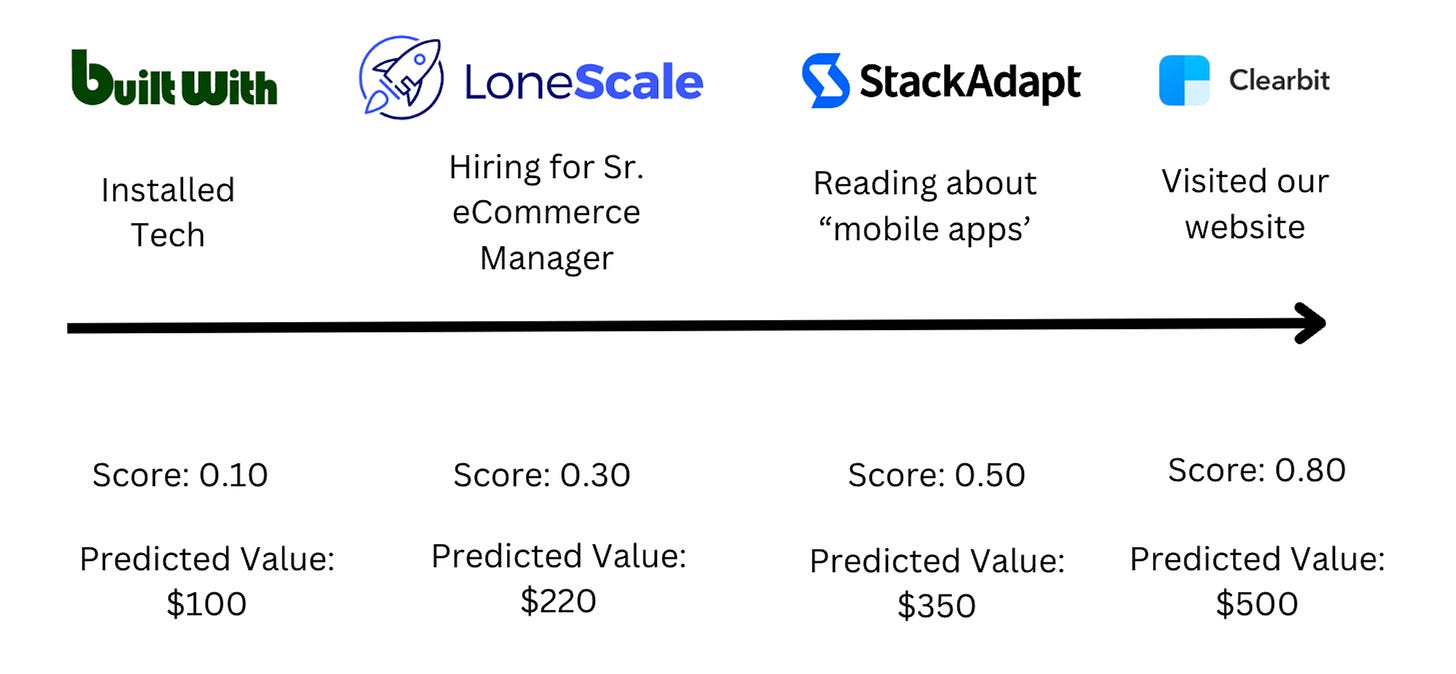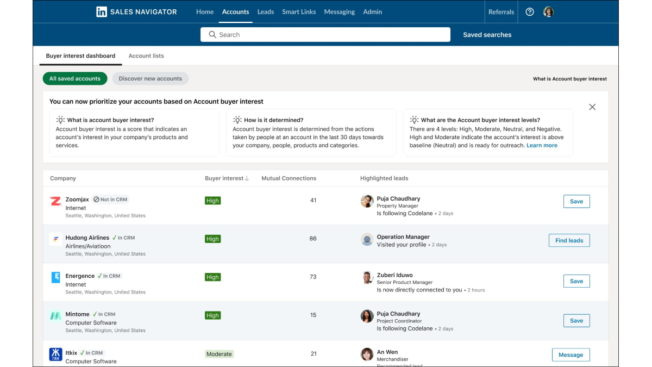Growth Outbound: The Distribution MOAT
Why fast-scaling startups focus on building their MOATs? What's its relation to Growth? What are the different setups of Growth Outbound by GTM motion? Discover my journey and playbook.
Who am I? Why MOAT?
Driving top-of-the-funnel acquisition for 6 years and built growth channels from idea to execution for many startups.
Started originally as a full-stack marketer and built ops, partner marketing/referrals, and demand gen from the ground up.
And while I shot marketing to the sky (20+ well-known partners were promoting us, source pipeline through events, opened the door for new agencies to drive revenue, ops supported Biz+Sales more than ever), I quickly realized 1 thing:
Each company has 1-3 unique growth levers.
And fast-scaling successful companies (from Salesforce to Rippling ) built MOATs on those levers that result in huge outcomes when combined with a big target market and a sustainable distribution strategy:
Salesforce built a MOAT by cultivating a large community of users who meet together regularly at in-person events.
Drift built a MOAT using content that its end-user community loved. The founders authored a book that became required reading for founders, and CMOs.
Rippling, Ramp built a MOAT by using signals to programmatically reach out to their ideal customers at scale.
Building a MOAT is not easy. And it requires a company DNA. And a diverse set of skills (compared to traditional skills of Sales and Marketing), and that’s why very few people or companies do it.
What I really enjoyed was identifying the right buying momentum, copywriting, and operationalizing top-of-the-funnel acquisition in a programmatic way.
Because acquiring customers is always a top priority and it’s one of the hardest things to figure out and scale.
And anything can be a MOAT - you just haven’t “operationalized” it yet.
If you know your ideal customers, what defines them, where they hang out, and how, you can programmatically reach out to them - with the right message, at the right time at the right channel.
And yes, the execution can be more automated, only automated, more manual, with or without sales reps — this part just really depends on what best fits your current stage right now.
And this is how I ended up building predictable, scalable, growth channels at scale.
So today I will guide you through my growth outbound playbook and the main considerations you should take into account.
1. Outbound in 2023
Outbound is harder than ever:
there are 50+ new tools that help you send better messages at scale
there is a new era of tools that help you bypass the email-sending limit
your budget is smaller, your sales team is smaller and you have to be leaner than ever
It doesn’t matter anymore if you are PLG, PLS, or a fully Sales-led org more or less involved with marketing: driving revenue is harder than ever.
And here’s the hard truth:
There's no magic tool that will immediately level up your results 😱.
It’s a mix of mindset, powerful processes, and strong collaboration. 💪
It's DNA with the right people, the right tech stack, and the right tactics to help your org focus on selling, not fixing, chasing, maintaining, or focusing on low-level tasks.
2. My Outbound Playbook
Sales often spend too much time doing these things instead of focusing on selling.
Also, as you grow, the alignment between marketing & sales can be even more challenging when you explore new segments, want to harmonize messaging, or want to tackle mid-market and enterprise at the same time (💡 hint: requires a different setup in Growth/Marketing, Sales, Ops):
Growth serves 2 key functions here:
Fill the pipeline with the best leads to drive more conversations, more relevant messaging, and timely interactions and drive TOFU
Improve efficiency and productivity to maximize the unit economics
So below are the main steps to define your own growth engine:
1. Define TAM, your IAP, and the best prospects
The main goal here is to define your IAP (Ideal Account Profile) to understand your customers and identify what works, frame it, and identify similar use cases by:
nr of stakeholders
sales cycle length
verticals, industries
So here are my fav questions:
What are the different use cases of your solution? → help you find new personas or new segments
What are your customer pain points or challenges? → defines messaging
Have you identified some patterns when it is easier to sell? → defines buying intent patterns
What are the events in your prospect’s life or triggers that drive your sales?
What are the events in your prospect’s life or triggers that prevent you from making a sale?
Now, analyze your historical data in your CRM or listen to calls to validate these patterns and better understand who your best customers:
Firmographic: vertical, company size, revenue
Technographic data: competitors, complementary solutions
Personas: title, seniority
Events: Github repo review, G2 review
Thirdly, you can also look at the inbound prospects and patterns:
What titles came inbound most often?
What are the most common keywords?
What are the events they mention in the sales calls? (i.e.: read this blog post, hired a new team member and were looking to X, tried Y solution but..)
Now that you know your IAP and persona, you can start to find the right personas to reach out to them. Tech you can use to source prospects:
Sales Nav
Data providers: Crunchbase, Zoominfo, BuiltWith
Communities: FB groups, Slack groups, WhatsApp (mostly invitation-based)
Other: GitHub repos, competitor social followers
(New!) Outreach tools that give you a database: Reply, Lemlist, Apollo
Follow me if you’d like to get a teardown of how to do automated outbound and get practical insights into building your top-of-the-funnel engines 👇
2. Score Accounts
If you’re an early-stage startup, you might skip this. If you’re more mature (Series B-ish), look at the data again to identify similarities between the above-mentioned data points and the deal lifecycles, ie.:
Should you prioritize certain verticals higher?
Are there any verticals that growing extremely fast and come inbound more often in the last 90 days and maybe you should focus more on them?
Does technology qualify somebody as an “ideal” account? What technology or firmographic points do so?
Here’s another example if you’re ready to take it to the next level :)
3. Leverage intents (= triggers, events, signals, insights)
Timing is 🗝️ in Outbound.
Here’s why: I’m a woman in my 30s, not planning to be pregnant yet and I got an ad that sells me pregnancy vitamins.
Do you think I will have ANY engagement with your ad?
Ofc, not.
So what do good marketers do to ensure you’re not spending money on me?
Exclude me from the target audience!
And that’s exactly how you should think about timing in Outbound. 💡💡💡
Who the group of people is, and when it’s the right time to reach out to your prospect to have the highest probability to START A CONVERSATION.
And an insight/trigger/buying intent (an event showing that a company is more likely to buy now) can help you reach out to the prospects at the right time by leveraging a specific buying moment, such as:
Fundraised
Hiring or New KDM hired
Customer switched jobs or switched employers (great for getting a warm intro to a new buying committee)
New technology installed, uninstalled
High growth
G2, Trustpilot, Shopify reviews
Visited website, downloaded content etc
To make it practical:
Selling a b2b sales software: hiring for a Sales Lead, expanding to new markets (need for different tooling?)
Selling to developers: forked, committed, or starred a repo on GitHub
If you’re not there yet, you can also get started with LinkedIn. Now it can give you engagement and buying insights on an account level (i.e.: senior leadership hire, growth trajectory, etc.):
And you not only can be relevant but you can use your insights to tailor the email - make it more personal, relevant, and timely:
Hiring intent
Company priorities and budget allocation
Used Technologies
KDM and team structure
GitHub Repo as a trigger
If you’re looking for inspo, here you can check my other copies.
Once you have the accounts list with relevant triggers, it’s time to build a repeatable bucket of accounts to target each week/month and enrich the company with relevant contacts.
Build your account enrichment and contact search processes
Now, there are 3 different scenarios of how you can do that.
I start with my LEAST favorite one to the best approaches:
Fully manual: reps are going manually on each LinkedIn company page and scrolling each page to find and copy/paste all the interesting contacts for your company. Benefit: no real benefit, ask any sales rep and they will tell you it’s a very time-consuming and soul-sucking task…. 🫠🫠
Semi-manual: accounts are fully enriched by Growth, but reps are required to find the right personas/KDMS. Benefit: no heavy lift on Ops (clearing is still required btw!)
Fully automated: have our Total Addressable Market (TAM) enriched with multiple data sources. Use tools that monitor all signals around your TAM and build a bucket of leads that you push them to the CRM through a reverse ETL tool. Benefit: sales only focus on selling, not the tedious time of prospecting (or if Marketing owns the top of the funnel, then they). But this requires a strong Ops infrastructure, so this is best for startups who want to scale FAST!
To give you a concrete example, most of the time I use Zapier/n8.io + different 3rd party tools + HubSpot to add the TAM in HubSpot, enrich it, add signals, and keep it up to date with contacts.
And here comes the 2nd magic - build your CRM as a source of truth and compute personalization inside the CRM!
Build CRM as a source of truth to personalize at scale
Ask any Growth or Ops person and they will tell you they built SOO MUCH for their own GTM teams and ended up somewhere in the universe but not in the sales or marketing hands….
So the most important part is to ensure adoption: make data easily visible and actionable for the teams and ensure they KNOW how to use it.
For example, our CRM (HubSpot + Salesforce) was the source of truth for our data. We built HubSpot to capture all top-of-the-funnel interactions and have a reduced CRM version in Salesforce, to keep it simple & actionable for reps.
Here’s an example of how it can look like for outbound:
Btw, we also added ads and content interactions + other channels. All the extra miles that we can help Sales being more effective and focus on selling.
Now the next thing you need to do is enablement (depending on where the BDRs belong to) to ensure the adoption. My best practices:
build Notion post mortem
hold an enablement when there is a major new release in process, data
share the main TRLD, have a “home” exercise, and do a quiz
have a dashboard to keep reps accountable
celebrate who are best leveraging insights + have a session to get feedback
Visual Outbound
There are 50+ tools that help you bypass the email limit, and act as a virtual SDR…
And while not all of these feel like human, frankly there is an adoption and results behind it.
So it doesn’t matter if you have a lot of good sales reps who are hungry or have a strong belt behind it: it’s about how you scale personalization and volume.
And one way to be personalized at scale is by being SUPER relevant. One way to do it is a semi-personalized video/photo where the background, voice logo, etc. is auto-populated, but even better if you can provide a better understanding of why you, why now, and what, in a visual way:
Here’s a visual outbound I built a while ago:
With scraping, you can get the merchant’s products, and pre-populate any mobile app section/page/push notification to show the merchant how exactly their mobile app would look like! (** The messaging and targeting are slightly different due to privacy and competitive purposes**)
3. Different setup of outbound by GTM motion
Here are 3 things I’m noticing on the market:
Brigi: when it’s best to automate vs. personalize?
A lot of people in the meantime: “Outbound is Dead” ☠️
Automation hurts
But if any of them are done correctly, outbound is smooth and drives an exceptional experience while also being super helpful for the revenue org by eliminating the tedious time of prospecting, and the low-value tasks.
So here are the different TOFU scenarios according to your GTM motion:
Follow me if you’d like to get a teardown of how to do automated outbound, or get practical insights into building your top-of-the-funnel engines 👇
And if you’re an early-stage startup, you can still implement these best practices. Here are my fav rules and best practices for when to automate:
high-TAM & low ACV, and clear persona (see more above)
the stage of the sales cycle (i.e. warm/cold, follow-ups (i.e. POC check-ins), multi-threading)
if you would send the same messages anyway
No personalization was found so the fallback is sending challenge-based messages customized to the Persona
bump emails (the case defines this)
social selling (i.e.: connection requests)
Founder-led sales: challenge-based, asking for product feedback, not sales, BizDev-focused
avoid spamming (don’t get marked as “don’t know this person”)
I see Growth as a strategic function, and depending on the GTM motion, either fully own & drive the top of the funnel and revenue or help Sales maximize their productivity & focus on high-value-added tasks, so they can ultimately drive more revenue.
This is why the alignment between the revenue teams is 🗝️ and should share the same, mutual goal: generate revenue.
Truly appreciate you reading this far! ❤️
If you’re interested in learning more, follow me on LinkedIn, and feel free to DM me.













Your detailed research and expertise are evident, making it an invaluable read. As a Salesguy myself, I understand the importance of effective distribution strategies and the challenges that come with it. Your article not only provided me with fresh perspectives but also reinforced the importance of a well-structured growth outbound approach.
Thanks for your help.